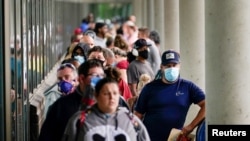Unemployment compensation claims remained elevated in the United States last week, the U.S. Labor Department reported Thursday, as the soaring number of coronavirus cases in the country continues to inhibit the world’s largest economy.
The government said 900,000 workers filed for benefits last week, down 26,000 from the revised figure of the previous week.
Now, as President Joe Biden starts his first days in office, the U.S. economy is facing new headwinds, with tens of thousands of people being infected daily and employers confronted with new orders from state and municipal officials to restrict business hours or to shut down to try to prevent the spread of the virus.
Two weeks ago, the government reported that U.S. employers cut 140,000 jobs in December, the first drop in job growth since the pandemic swept into the country last March and April and sent the national economy reeling.
For weeks, the number of jobless benefit claims had stayed steady in the 700,000 to 800,000 range until the two most recent reports, all of which are still well below the 6.9 million record number of claims filed late last March as the pandemic took hold in the U.S. Still, all of the weekly jobless benefit claim figures in the last 10 months have been above the highest pre-pandemic level in records going back to the 1960s.
The national government has started to make $300-a-week extra payments to the jobless on top of less generous state benefits, a stipend that will last for 11 weeks. Biden, as part of his proposed $1.9-trillion coronavirus relief package, is trying to boost that stipend to $400 a week through September.
Biden has narrow majorities in both the Senate and House of Representatives, possibly easing approval of his relief plan, but only if Democrats vote as a bloc or the president can convince some Republican lawmakers to support it.
However, it took months for the administration of former President Donald Trump and fractious lawmakers in Congress to reach a deal on a $900 billion coronavirus relief measure that included the $300-a-week jobless aid, suggesting that any new spending might also be tough to negotiate.
Nearly 10 million of the 22 million workers who lost jobs remain unemployed in the U.S. The jobless rate held steady at 6.7% in December, with many economists saying the figure could remain elevated for months.
U.S. employers have called back millions of workers who were laid off during business shutdowns earlier this year. But some hard-hit businesses have been slow to ramp up their operations again or have closed permanently, leaving workers idled or searching for new employment.
Some state and municipal officials now, however, have imposed new restrictions on businesses, forcing owners to once again lay off workers.
The aid pact Trump signed includes $600 payments to more than 80% of adult Americans, excluding the biggest wage earners. Biden is asking for additional $1,400 payments.
In the December negotiations, Republican lawmakers said the additional aid was too costly. With Democrats controlling the levers of power in Congress and the White House after Biden’s inauguration Wednesday, more aid could be approved as the death toll mounts from the coronavirus.
While the U.S. economy has regained strength since the earliest days of the coronavirus pandemic, growth slowed in the last three months of 2020. The U.S. has now recorded 406,000 coronavirus deaths and 24.4 million infections, both figures higher than what’s being reported in any other country, according to Johns Hopkins University.
Economists, meanwhile, expect the U.S. economy’s recovery to gain momentum in the second half of 2021, after passage of the December stimulus package and as millions of people eventually are inoculated against the disease.
More than 16.5 million Americans have been vaccinated so far, but the figure is still short of the 20 million the Trump administration predicted would get the shots by the end of December.









